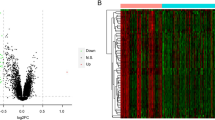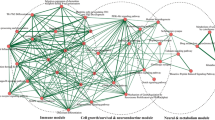Abstract
Alzheimer’s disease (AD) affects a significant portion of elderly people worldwide. Although the amyloid-β (Aβ) cascade hypothesis has been the prevailing theory for the molecular mechanism of AD in the past few decades, treatment strategies targeting the Aβ cascade have not demonstrated effectiveness as yet. Thus, elucidating the spatial and temporal evolution of the molecular pathways in AD remains to be a daunting task. To facilitate novel discoveries in this filed, here, we have integrated information from multiple sources for the better understanding of gene functions in AD pathogenesis. Several categories of information have been collected, including (1) gene dysregulation in AD and closely related processes/diseases such as aging and neurological disorders, (2) correlation of gene dysregulation with AD severity, (3) a wealth of annotations on the functional and regulatory information, and (4) network connections for gene-gene relationship. In addition, we have also provided a comprehensive summary for the top ranked genes in AlzBase. By evaluating the information curated in AlzBase, researchers can prioritize genes from their own research and generate novel hypothesis regarding the molecular mechanism of AD. To demonstrate the utility of AlzBase, we examined the genes from the genetic studies of AD. It revealed links between the upstream genetic variations and downstream endo-phenotype and suggested several genes with higher priority. This integrative database is freely available on the web at http://alz.big.ac.cn/alzBase.





Similar content being viewed by others
References
Lei H (2010) Amyloid and Alzheimer’s disease. Protein Cell 1(4):312–314
Han G et al (2014) Genomics in neurological disorders. Genomics Proteomics Bioinformatics 12(4):156–163
Herrup K et al (2013) Beyond amyloid: getting real about nonamyloid targets in Alzheimer’s disease. Alzheimers Dement 9(4):452–458 e1
Bertram L et al (2007) Systematic meta-analyses of Alzheimer disease genetic association studies: the AlzGene database. Nat Genet 39(1):17–23
Lambert JC et al (2013) Meta-analysis of 74,046 individuals identifies 11 new susceptibility loci for Alzheimer’s disease. Nat Genet 45(12):1452–1458
Zhang B et al (2013) Integrated systems approach identifies genetic nodes and networks in late-onset Alzheimer’s disease. Cell 153(3):707–720
Sun J et al (2012) Down-regulation of energy metabolism in Alzheimer’s disease is a protective response of neurons to the microenvironment. J Alzheimers Dis 28(2):389–402
Liang D et al (2012) Concerted perturbation observed in a hub network in Alzheimer’s disease. PLoS One 7(7):e40498
Wang J et al (2014) Chromosome 19p in Alzheimer’s disease: when genome meets transcriptome. J Alzheimers Dis 38:245–250
Hahs DW et al (2006) A genome-wide linkage analysis of dementia in the Amish. Am J Med Genet B Neuropsychiatr Genet 141B(2):160–166
Wijsman EM et al (2004) Evidence for a novel late-onset Alzheimer disease locus on chromosome 19p13.2. Am J Hum Genet 75(3):398–409
Feng X et al (2014) Robust gene dysregulation in Alzheimer’s disease brains. J Alzheimers Dis 41:587–597
Han G et al (2013) Characteristic transformation of blood transcriptome in Alzheimer’s disease. J Alzheimers Dis 35:373–386
Bai Z et al (2014) Distinctive RNA expression profiles in blood associated with Alzheimer disease after accounting for white matter hyperintensities. Alzheimer Dis Assoc Disord 28(3):226–233
Sun J et al (2014) Hidden risk genes with high-order intragenic epistasis in Alzheimer’s disease. J Alzheimers Dis 41:1039–1056
Hawrylycz MJ et al (2012) An anatomically comprehensive atlas of the adult human brain transcriptome. Nature 489(7416):391–399
Welter D et al (2014) The NHGRI GWAS Catalog, a curated resource of SNP-trait associations. Nucleic Acids Res 42(Database issue):D1001–D1006
Webster JA et al (2009) Genetic control of human brain transcript expression in Alzheimer disease. Am J Hum Genet 84(4):445–458
Berchtold NC et al (2008) Gene expression changes in the course of normal brain aging are sexually dimorphic. Proc Natl Acad Sci U S A 105(40):15605–15610
Liang WS et al (2008) Alzheimer’s disease is associated with reduced expression of energy metabolism genes in posterior cingulate neurons. Proc Natl Acad Sci U S A 105(11):4441–4446
Nunez-Iglesias J et al (2010) Joint genome-wide profiling of miRNA and mRNA expression in Alzheimer’s disease cortex reveals altered miRNA regulation. PLoS One 5(2):e8898
Williams C et al (2009) Transcriptome analysis of synaptoneurosomes identifies neuroplasticity genes overexpressed in incipient Alzheimer's disease. PLoS One 4(3):e4936
Iwamoto K et al (2004) Molecular characterization of bipolar disorder by comparing gene expression profiles of postmortem brains of major mental disorders. Mol Psychiatry 9(4):406–416
Iwamoto K, Bundo M, Kato T (2005) Altered expression of mitochondria-related genes in postmortem brains of patients with bipolar disorder or schizophrenia, as revealed by large-scale DNA microarray analysis. Hum Mol Genet 14(2):241–253
Hodges A et al (2006) Regional and cellular gene expression changes in human Huntington’s disease brain. Hum Mol Genet 15(6):965–977
Moran LB et al (2006) Whole genome expression profiling of the medial and lateral substantia nigra in Parkinson’s disease. Neurogenetics 7(1):1–11
Ryan MM et al (2006) Gene expression analysis of bipolar disorder reveals downregulation of the ubiquitin cycle and alterations in synaptic genes. Mol Psychiatry 11(10):965–978
Lesnick TG et al (2007) A genomic pathway approach to a complex disease: axon guidance and Parkinson disease. PLoS Genet 3(6):e98
Harris LW et al (2008) The cerebral microvasculature in schizophrenia: a laser capture microdissection study. PLoS One 3(12):e3964
Maycox PR et al (2009) Analysis of gene expression in two large schizophrenia cohorts identifies multiple changes associated with nerve terminal function. Mol Psychiatry 14(12):1083–1094
Zheng B et al (2010) PGC-1alpha, a potential therapeutic target for early intervention in Parkinson’s disease. Sci Transl Med 2(52):52ra73
Voineagu I et al (2011) Transcriptomic analysis of autistic brain reveals convergent molecular pathology. Nature 474(7351):380–384
Ginsberg MR et al (2012) Brain transcriptional and epigenetic associations with autism. PLoS One 7(9):e44736
Lu T et al (2004) Gene regulation and DNA damage in the ageing human brain. Nature 429(6994):883–891
Gibbs JR et al (2010) Abundant quantitative trait loci exist for DNA methylation and gene expression in human brain. PLoS Genet 6(5):e1000952
Somel M et al (2010) MicroRNA, mRNA, and protein expression link development and aging in human and macaque brain. Genome Res 20(9):1207–1218
Colantuoni C et al (2011) Temporal dynamics and genetic control of transcription in the human prefrontal cortex. Nature 478(7370):519–523
Hernandez DG et al (2012) Integration of GWAS SNPs and tissue specific expression profiling reveal discrete eQTLs for human traits in blood and brain. Neurobiol Dis 47(1):20–28
Trabzuni D, Thomson PC (2014) Analysis of gene expression data using a linear mixed model/finite mixture model approach: application to regional differences in the human brain. Bioinformatics 30(11):1555
Scherzer CR et al (2007) Molecular markers of early Parkinson's disease based on gene expression in blood. Proc Natl Acad Sci U S A 104(3):955–960
Blalock EM et al (2004) Incipient Alzheimer’s disease: microarray correlation analyses reveal major transcriptional and tumor suppressor responses. Proc Natl Acad Sci U S A 101(7):2173–2178
Dunckley T et al (2006) Gene expression correlates of neurofibrillary tangles in Alzheimer’s disease. Neurobiol Aging 27(10):1359–1371
Kaizer EC et al (2007) Gene expression in peripheral blood mononuclear cells from children with diabetes. J Clin Endocrinol Metab 92(9):3705–3711
Misu H et al (2010) A liver-derived secretory protein, selenoprotein P, causes insulin resistance. Cell Metab 12(5):483–495
Jin W et al (2011) Increased SRF transcriptional activity in human and mouse skeletal muscle is a signature of insulin resistance. J Clin Invest 121(3):918–929
Keller P et al (2011) Gene-chip studies of adipogenesis-regulated microRNAs in mouse primary adipocytes and human obesity. BMC Endocr Disord 11:7
Skov V et al (2012) Global gene expression profiling displays a network of dysregulated genes in non-atherosclerotic arterial tissue from patients with type 2 diabetes. Cardiovasc Diabetol 11:15
van Tienen FH et al (2012) Physical activity is the key determinant of skeletal muscle mitochondrial function in type 2 diabetes. J Clin Endocrinol Metab 97(9):3261–3269
Davis AP et al (2013) The Comparative Toxicogenomics Database: update 2013. Nucleic Acids Res 41(Database issue):D1104–D1114
Irizarry RA et al (2003) Exploration, normalization, and summaries of high density oligonucleotide array probe level data. Biostatistics 4(2):249–264
Hong F et al (2006) RankProd: a bioconductor package for detecting differentially expressed genes in meta-analysis. Bioinformatics 22(22):2825–2827
Sun J et al (2012) iBIG: an integrative network tool for supporting human disease mechanism studies. Genomics Proteomics Bioinformatics 11(3):166–171
Benjamini Y et al (2001) Controlling the false discovery rate in behavior genetics research. Behav Brain Res 125(1–2):279–284
Wickham H (2007) Reshaping data with the reshape package. J Stat Softw 21(12):1–20
Ginestet C (2011) ggplot2: elegant graphics for data analysis. J Royal Stat Soc Series a-Stat Soc 174:245–245
Langfelder P, Horvath S (2008) WGCNA: an R package for weighted correlation network analysis. BMC Bioinform 9:559
Csardi G, Nepusz T (2006) The igraph software package for complex network research. Inter J Compl Syst. 1695(5)
Viechtbauer W (2010) Conducting meta-analyses in R with the metafor package. J Stat Softw 36(3):1–48
Li W (1990) Mutual information functions versus correlation functions. J Stat Phys 60(516):823–836
Jean Hausser KS (2009) Entropy inference and the James-Stein estimator, with application to nonlinear gene association networks. J Machine Learn Res. doi:10.1145/1577069.1755833
Wang J, Yu JT, Tan L (2014) PLD3 in Alzheimer’s disease. Mol Neurobiol. doi:10.1007/s12035-014-8779-5
Cruchaga C et al (2013) Rare coding variants in the phospholipase D3 gene confer risk for Alzheimer’s disease. Nature 505(7484):550–554
Akhtar MW et al (2012) In vivo analysis of MEF2 transcription factors in synapse regulation and neuronal survival. PLoS One 7(4):e34863
Bienvenu T et al (2013) Refining the phenotype associated with MEF2C point mutations. Neurogenetics 14(1):71–75
Ryan SD et al (2013) Isogenic human iPSC Parkinson’s model shows nitrosative stress-induced dysfunction in MEF2-PGC1alpha transcription. Cell 155(6):1351–1364
Wang X et al (2014) Genetic determinants of disease progression in Alzheimer’s disease. J Alzheimers Dis. doi:10.3233/JAD-140729
Beecham GW et al (2014) Genome-wide association meta-analysis of neuropathologic features of Alzheimer’s disease and related dementias. PLoS Genet 10(9):e1004606
Acknowledgments
This work was supported by the grants from the National Basic Research Program of China (973 Program, Grant No. 2014CB964901) and National High Technology Research and Development Program (863 Program, Grant No. 2015AA020100) awarded to HL from the Ministry of Science and Technology of China.
Conflict of Interest
The authors declare that there are no conflicts of interest.
Author information
Authors and Affiliations
Corresponding author
Additional information
Zhouxian Bai and Guangchun Han contributed equally to the work.
Electronic supplementary material
Below is the link to the electronic supplementary material.
Supplementary Table 1
(DOCX 21 kb)
Supplementary Table 2
(DOCX 18 kb)
Supplementary Table 3
(DOCX 17 kb)
Supplementary Table 4
(DOCX 16 kb)
Supplementary Figure 1
(DOCX 150 kb)
Supplementary Figure 2
(DOCX 528 kb)
Supplementary Figure 3
(DOCX 370 kb)
Rights and permissions
About this article
Cite this article
Bai, Z., Han, G., Xie, B. et al. AlzBase: an Integrative Database for Gene Dysregulation in Alzheimer’s Disease. Mol Neurobiol 53, 310–319 (2016). https://doi.org/10.1007/s12035-014-9011-3
Received:
Accepted:
Published:
Issue Date:
DOI: https://doi.org/10.1007/s12035-014-9011-3




